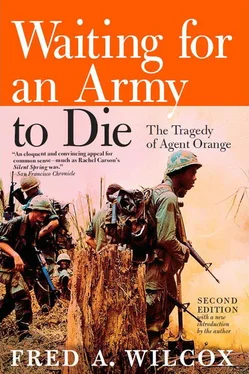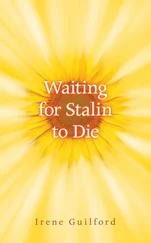Most of the informants interviewed reported widespread deaths among their domestic animals following the spraying. The Long Djon informants noted that since they were refugees they had few animals, but most of their chickens and pigs died shortly after the spraying, and the Dak Rosa villagers reported the same thing. Informants from Dak Tang Plun said that all of their chickens, most of their pigs, and some of their cattle died, and the young man from Plei Ro-O reported the same thing, specifying that this occurred within four or five days after the spraying. He also noted that villagers found a number of dead wild animals, particularly wild boar, in the nearby forests. Polei Krong informants also pointed out they found dead wild boar in the forest. They, too, saw all of their chickens, pigs, dogs, and small cattle die, although big cattle survived. Both the Polei Kleng and the Plei Jar Tum villagers said that their pigs, dogs, and chickens died, and the latter added that they also lost cattle. Plei Ngol Drong informants reported that all of the pigs, chickens, dogs, goats, (they noted that goats are “very strong”), and cattle died…
Although some of these reports may sound highly exaggerated, Dr. Hickey and others have pointed out that before the US sprayed their villages and farmlands, the highlanders of Vietnam had never been exposed to synthetic drugs or chemicals, and it is conceivable that their susceptibility to herbicides was much greater than that of people living in highly industrialized nations where even tests on young children have demonstrated that their bodies contain residues of synthetic substances. Some areas of Vietnam were also sprayed repeatedly with Agent Orange containing levels of TCDD hundreds of time higher than the dioxin content of 2,4,5-T now in use in the United States. Yet even after Dow had “refined” its production process to reduce the content of dioxin in 2,4,5-T, the effects of this herbicide on animals and humans have been extremely toxic, although without a national effort to determine just how many people have become ill, died, lost their farm animals, and left their land because of herbicide spraying, the full extent of the problem may never be known.
Consider, for example, the case of Eve and Vern DeRock, who were living on a farm in an Oregon valley sprayed by International Paper Company in March 1977. One week after the spraying, fifteen of the DeRock’s experimental cows aborted their calves. But like so many people who believed that “killing off a few weeds” would never do anyone harm, the DeRocks dismissed the miscarriages as “bad luck” and tried to re-breed their heifers. Out of fifty-four, only six conceived and the DeRocks, totally unaware that TCDD could be stored in beef fat, wound up butchering a few cows for their own use and selling the rest. The following spring when the surviving cows gave birth, five of their offspring were born with gross deformities and died within four days. Soon the DeRocks began experiencing stomach pains, loss of strength, and “summer colds” that seemed to resist ordinary treatment. Following a fire in an area of their farm that had been treated with herbicides just a few weeks earlier, Vern collapsed. And after a series of tests, doctors performed exploratory surgery on Eve, only to discover chronic liver failure, sending her home with the expectation that she would die as soon as her liver stopped functioning. 4
But through all this the DeRocks did not stop eating the beef and butter they had stored in their freezer. No one from the company that was spraying herbicides or a state or federal health agency appeared to explain to them how dioxin gets into the food chain and consequently into the human body. More than a year after their land had been sprayed and their lives disrupted, if not ruined, the DeRocks happened to see a documentary on Vietnam veterans that explained the health effects of Agent Orange. The documentary also described the research of Vietnamese doctors who have linked Agent Orange to liver cancer in their own country, and the very next day the DeRocks stopped eating the meat and butter they had stored. Their health began to improve, but they have not been compensated for their suffering and, they realize, the Vietnamization of Oregon continues. Even after the emotional and financial hardships the DeRocks have endured, they cannot be sure that the helicopters will not return—there is no law to prevent them from doing so.
Bonnie Hill has heard this story, and many others. But, she sighs, “after all that’s gone on, it would still be virtually impossible to prove in a court of law that you had been exposed and then, even worse, that what happened afterwards was the result of that exposure. That’s one thing that happened with the miscarriages. Dow just dredged up every possible factor that could influence a miscarriage or spontaneous abortion. Well, of course there are a lot of things that can cause miscarriages, but I really resent their insinuations—it’s been a little more than that, actually—that this is a great area for growing marijuana, and it’s because we don’t want our marijuana plantations killed off that we’re against spraying. Someone has also spread the rumor that our miscarriages are because we are ‘remnants of the sixties flower children’ who overindulge in drugs. I’ve lived here for eleven years, and I can assure you that opponents of herbicide spraying come from all walks of life. Some of them even work for the timber industry, and there are absolutely no marijuana plantations in the Alsea area. That’s one ploy that just won’t work—not here, anyway.”
Dow has also challenged the EPA’s decision to place a limited suspension order on domestic use of 2,4,5-T, [24] Although the EPA passed its suspension order on certain domestic uses of 2,4,5-T in February 1979, there is evidence that the use of this herbicide has actually increased each year since the suspension order was passed.
arguing that the Alsea study was not comprehensive enough to merit the EPA’s conclusions.
“One of the problems we have had all along,” Hill explains, “is that the media has always given people the impression that the EPA’s study was based on only nine women living in the Alsea area, when in fact the EPA actually covered a sixteen-hundred-square-mile area, and of course years of research into the effects of 2,4,5-T influenced their decision as well. I don’t mean to disparage the media altogether, because we received international coverage and it was rather surprising, even a bit overwhelming, because people came from New Zealand, England, Germany, and Australia to talk with us, and this of course increased people’s awareness of this problem. Our main criticism of the EPA study is that they only examined hospital records, rather than talking with more of the people who lived in this area, because very few spontaneous abortions are treated in hospitals these days. They are almost all treated in doctor’s offices, or people don’t go to the doctor at all; it’s just something that happens in their homes. Out of the first eleven spontaneous abortions that we found out about, only two had been treated in hospitals, and that’s a fairly representational figure—all the rest being treated in doctor’s offices—so if the EPA really wanted to get a true feeling of what was going on here they should have gone to doctors’ offices, which is something we pressed for from the very beginning. So actually, in spite of our good feelings about the suspension order, we still feel that no one has really taken a thorough look at just what had been going on here.”
Prior to the EPA’s Emergency Suspension Order, 2,4,5-T was undergoing scrutiny through a process called RPAR, or “Rebuttable Presumption Against Registration.” Having decided that on the basis of its evidence there were serious questions involved in the continued domestic use of 2,4,5-T, the EPA had announced that it was considering canceling registration for this product, but would give the manufacturer the opportunity to present arguments for keeping the herbicide on the market. The Emergency Suspension Order superseded RPAR and the two hearings were merged into one, which was to be divided into two sections—first, the risks involved in, and second, the benefits derived from using 2,4,5-T.
Читать дальше











